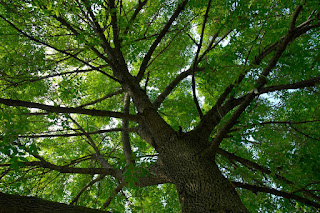
The Ash tree is a deciduous tree that belongs to the Oleaceae family. There are 45 to 65 species of ash that can be found in the northern parts of Europe, Asia, and North America. Ash grows in cool and warm climates, in moist, well-drained soils, in areas with sufficient direct sunlight. People grow ash trees for ornamental purposes and because of the wood it is used in numerous industries. Unfortunately, ash trees are often attacked by the emerald ash borer (species of beetle), which destroys vessels of the plant system and induces rapid tree death.
Size of ash tree depends on the species. It can grow from 30 feet (Velvet Ash) to 120 feet (White Ash) in height and 40 to 50 feet in width.
Like the Sycamore, it drops winged seed pods called ‘ash keys’ in autumn, which contain the seeds. Ash keys hang in great bunches from autumn onwards often remaining right through winter.
Ash tree has grayish bark that is smooth in young trees. Bark becomes furrowed, composed of diamond-like pieces in old trees.
Ash Trees come into leaf much later than any other trees in the UK.
Ash tree have strong and wide root system. Two ash trees need to be separated at least 60 feet to ensure enough space for development of root system.
Ash leaves are made up of many opposing leaflets, which lie along a midrib; the whole leaf is on a stalk.
Ash tree develops compound leaves. They are 8 to 15 inches long and consist of 5 to 13 oval leaflets with toothed margins. Leaves are green during the spring, and yellow, orange, red and purple during the autumn.
The trunk of the Ash Tree is olive green in colour and smooth when young, then, as the tree matures the bark becomes ridged.
Ash tree produces miniature purple flowers arranged in clusters. Male and female flowers develop on separate plants (dioecious plant). Flowers are pollinated by wind.
The branches, which have a greenish grey colour, often fall leaving holes, which are occupied by nesting birds. The branches have a tendency to incline downwards before rising up near their end.
Fruit of ash tree is called samara. Samara is one to two inches long, flat and consists of thin membrane that protects miniature seeds.
Ash trees are excellent ‘pioneers’ and they will often be the second native tree to colonise unwooded areas, following hawthorn.
Both domestic (cows and goats) and wild (rabbits) animals like to eat leaves and branches of ash tree.
Over the past century, ash has increased in the UK and is slowly taking over ancient woods.
Ash tree produces substance that is similar to olive oil. This substance can be used in treatment of stomach disorders. People in certain parts of Britain use bark of ash tree to treat warts on the skin.
Ash is the original ‘lightning tree’ and mature ash are regularly split in half by strikes, yet continue to grow.
During the 19th century, ash trees were used in the production of carriages. They were also used in the manufacture of boats and airplanes in the past.
Ash trees thrive in limestone areas, and small remnant areas in the White Peak (Derbyshire) suggest the whole area was covered with ancient ash forest at one time.
Wood of ash tree is strong and elastic at the same time which makes it perfect for the production of baseball bats, hockey sticks, tennis rackets and canoe paddles.
Ash is a very hard wood and is still used for tool handles of all kinds; snooker cues, oars, cartwheels etc. Its strength probably led to its adoption in folklore as a representation of masculinity.
Veneers made of ash trees are used in the manufacture of office furniture.
In Irish legend, famous ash trees included the Tree of Uisnech, the Tree of Tortu and the Bough of Dathi.
Ash tree is also used in the production of music instruments such as electric guitars and drums.
The juice of the branches contains the effective element of quinine and was used as a cure-all.
Ash tree is used as firewood and for smoking of food, especially meat.
Nicholas Culpeper the famous herbalist recommended eating ash seeds because: “the kernels within the husks commonly called ashen keys…prevaileth against stitches and pains in the side”.
According to the old Viking legend, Yggdrasil, also known as the Tree of the World, touches hell with its roots and heaven with its crown. Vikings also believed that mythological god Odin created first man on earth using the ash tree.
Ash is our tallest native deciduous trees when fully mature and you might be surprised to know that it actually makes up a part of the Olive tree family.
Lifespan of ash tree depends on the species. They can survive from 30 to 300 years.









